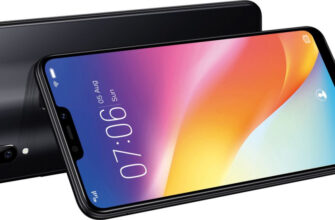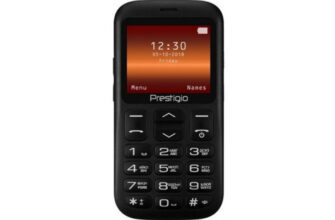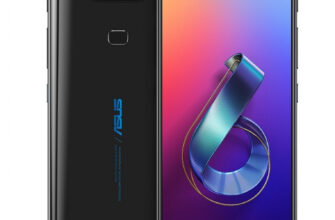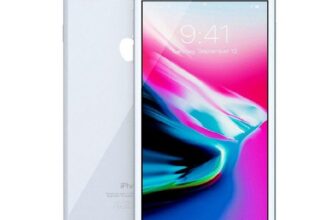Review of the best according to the editorial board. On the selection criteria. This material is subjective and does not constitute advertising and does not serve as a purchase guide. Before buying, you need to consult with a specialist.
Buyers choose modern smartphones according to a variety of criteria – a prestigious brand, a flagship of their favorite line, a large screen, and so on. But the main indicator, as always, is the speed of work. And for this part, almost everything depends on the central processor. Even the graphics cards in modern smartphones are integrated into the processor.
The editors have prepared for you a special review of smartphones on the February-March 2020 market with the most powerful processors to date. Contrary to possible expectations, not only super-expensive flagships are presented here, but also some quite affordable models. To analyze the technical characteristics, the data of the resource https://rankquality.com/smartphones/ were used.
- Rating of the best smartphones with a powerful processor
- The best budget smartphones with the most powerful processor
- Lenovo Z5 Pro GT
- Advantages
- disadvantages
- Xiaomi Redmi K20 Pro
- Advantages
- disadvantages
- Realme X2 Pro
- Advantages
- disadvantages
- The best premium smartphones with the most powerful processor
- Xiaomi Black Shark 2 Pro
- Advantages
- disadvantages
- Huawei P30 Pro
- Advantages
- disadvantages
- ASUS ZenFone 6
- Advantages
- disadvantages
- Samsung Galaxy S10 +
- Advantages
- disadvantages
- ASUS ROG Phone 2
- Advantages
- disadvantages
- OnePlus 7T Pro
- Advantages
- disadvantages
- iPhone XS Max
- Advantages
- disadvantages
Rating of the best smartphones with a powerful processor
| Nomination | a place | Name of product | price |
| The best budget smartphones with the most powerful processor | 1 | Lenovo Z5 Pro GT | RUB 10 490 |
| 2 | Xiaomi Redmi K20 Pro | RUB 27,900 | |
| 3 | Realme X2 Pro | RUB 31,000 | |
| The best premium smartphones with the most powerful processor | 1 | Xiaomi Black Shark 2 Pro | RUB 39,990 |
| 2 | Huawei P30 Pro | RUB 40 490 | |
| 3 | ASUS ZenFone 6 | RUB 44 380 | |
| 4 | Samsung Galaxy S10 + | RUB 60 490 | |
| 5 | ASUS ROG Phone 2 | RUB 69,990 | |
| 6 | OnePlus 7T Pro | RUB 49 870 rub. | |
| 7 | iPhone XS Max | 60 750 |
The best budget smartphones with the most powerful processor
First, let's present the top three smartphones with the most powerful processors that can be bought at a relatively affordable price. 'Comparatively', because the cost of any copy is still in the tens of thousands of rubles, and as a conditional limitation, we set an upper ceiling of +/- 30 thousand rubles.
Lenovo Z5 Pro GT
Rating: 4.9

A whole story is connected with this smartphone – initially it was released only for the domestic market of China, but did not receive explosive popularity. As a result, it fell in price, and they began to actively sell it at the budget price. Now this model can still be bought, although not everywhere. Let's see what this slightly strange, but still very interesting smartphone is.
Let's start with the main thing – the processor. Here is the eight-core flagship Qualcomm Snapdragon 855. Considering when Lenovo the Z5 Pro GT was announced, the first versions (without the GT prefix) were equipped with less powerful processors Qualcomm Snapdragon 710. Then the manufacturing company steadily pulled itself up to follow the progress. The most popular configuration includes 8GB of LPDDR4X RAM and 256GB of internal memory. It is also the most 'stuffed' one, if you wish, you can find simpler modifications with 128GB of internal memory. Integrated graphics – Adreno 640.
The screen size of this model is 6.39 inches. Matrix – Super AMOLED with a resolution of 2340×1080. Case dimensions – 155.1x73x9.3mm, device weight – 210g. Classic design. On the back there is a block of paired cameras Sony IMX 576 and 519 with a resolution of 24 and 16 megapixels, respectively. Front-facing cameras – 16MP and 8MP.
The model has a built-in dual-band WiFi 802.11a / b / g / n / ac module and Bluetooth version 5.0. Satellite navigation supports all available systems, including the European Galileo network. In terms of cellular communication, all standards are supported up to 4G LTE in different versions.
Additional functions and capabilities: built-in finger scanner, Dolby Atmos sound enhancement technology, NFC module, compass (magnetic), connection of an external keyboard and other devices using On-the-Go (OTG) technology.
In terms of autonomy, this is not the strongest point Lenovo of the Z5 Pro GT. A rather mediocre 3350mAh battery is installed here. On the other hand, it is not entirely legitimate to consider this a disadvantage, since really capacious batteries in smartphones today, if not uncommon, then certainly not a widespread phenomenon.
What really poses a problem with this model is the initial focus on the Chinese market. It's not so easy to buy this model in Russia, and there will be problems with localization, since it is completely absent. But with enthusiasm and persistence, the Lenovo Z5 Pro GT delivers impressive power for a reasonable price.
Advantages
- image quality;
- Super matrix AMOLED;
- speed of work;
- OTG support;
- NFC module;
disadvantages
- not too capacious battery;
- there is no Russian localization, much needs to be configured and flashed manually.
Xiaomi Redmi K20 Pro
Rating: 4.8
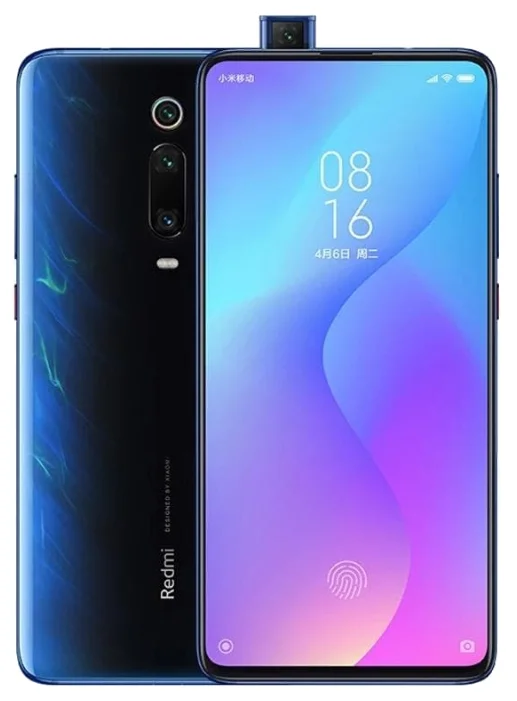
The brand Xiaomi, just like Lenovo is closely associated with inexpensive and high-quality electronics. So here too – the smartphone Xiaomi Redmi K20 Pro has a top processor Qualcomm Snapdragon 855 on board, and it costs approximately 22-28 thousand rubles, depending on the configuration for Russian trading platforms.
The graphics card here is the one “dictated” by the processor, namely the Adreno 640. The configuration with 6GB RAM and 64GB built-in memory is the minimum and the most affordable. The entire most popular cellular spectrum is supported up to 4G LTE and, in particular, VoLTE. Wireless – Wi-Fi 802.11ac, support for direct transmission between devices Wi-Fi Direct, Bluetooth version 5.0, NFC module, geolocation by GPS and GLONASS systems.
Smartphone body dimensions – 74.3×156.7×8.8mm, weight – 191g. The design is classic, hereinafter this applies to all the presented models, and we will indicate some noteworthy nuances, if any. Screen (matrix) type – AMOLED. The diagonal is 6.39 inches, the resolution is 2340×1080 with a density of 403 pixels per inch.
Rear cameras configuration Xiaomi Redmi K20 Pro – three modules with a resolution of 48, 8 and 13Mpix with apertures of F / 1.75, F / 2.40 and F / 2.40, respectively, has an LED flash. 2x optical zoom, autofocus, macro mode. Supports video shooting with a resolution of 4K 3840×2160. Front camera – 20MP.
The battery in this model is worth praising. The manufacturer 'forked out' for as much as 4000mAh of capacity, although less pretentious models are often equipped with weaker batteries. Charging via USB Type-C, there is a fast charging function.
A separate plus for many users – the manufacturer did not follow the trends and nevertheless equipped this model with the usual classic 3.5mm mini-jack audio output. But this advantage, unfortunately, is 'compensated' by a more tangible drawback – there is no slot for flash memory cards, and this is already a tangible disadvantage. The factory one MIUI also leaves much to be desired, and for comfortable use it is recommended to change the firmware to the global European one.
Advantages
- AMOLED – matrix;
- high-quality image;
- speed of work;
- video recording in 4K;
- capacious battery;
- fast charging function;
- classic headset output 3.5mm;
- voice control.
disadvantages
- inconveniences and deficiencies of the standard MIUI;
- external memory cards are not supported.
Realme X2 Pro
Rating: 4.7
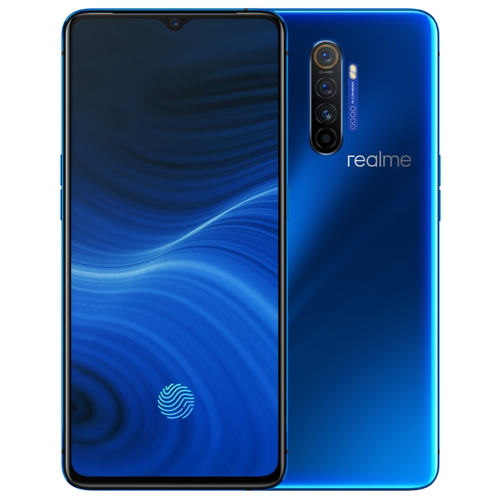
The selection of the best inexpensive smartphones with the most powerful processor according to the magazine is a new product of the market. It's an inexpensive flagship (and it's not an oxymoron) Realme X2 Pro. The manufacturer is just entering the market, and in order to somehow stand out against the background of powerful leaders, he is forced to reduce the price to a minimum, even for such bright new items.
Here installed as the center of the system is not just Qualcomm Snapdragon 855, but 855 Plus. In fact, this is the same 855, but factory overclocked to 2960 MHz. The graphics are obviously the same as in the two smartphones described above – Adreno 640. The most popular configuration is 8GB of RAM and 128GB of built-in data storage. There are modifications with 12GB of RAM and an expanded amount of internal memory.
Device dimensions – 75.7x161x8.7mm, weight – 199g. Screen AMOLED 6.5 inches diagonal with a resolution of 2400×1080 at a pixel density of 405 per inch. The aspect ratio of the sides of the screen is 20: 9. There are four rear cameras: the main 64MP, 8MP macro, 13MP telephoto and 2MP depth sensor. Apertures – F / 1.80, F / 2.20, F / 2.50 and F / 2.40, respectively. Optical zoom is 2x and hybrid zoom is 5x by working together optical zoom and telephoto lens.
The improved front camera is a characteristic and pleasant solution for smartphones Realme, which has become a good tradition. Here the front camera has a resolution of 16Mpix and is complemented by a whole set of intelligent tools for shooting in the dark, beautification, etc.
The set of capabilities for different types of wireless communication and satellite positioning is truly flagship here: 4G LTE, Wi-Fi 802.11ac, Bluetooth version 5.0, NFC module, all four navigation systems – American GPS, Russian GLONASS, Chinese BeiDou and European Galileo.
Power and autonomy are provided by a 4000mAh non-removable battery with the Oppo VOOC 3.0 fast charging function. Unlike the previous model, here such a capacity shows a slightly greater autonomy. So, according to independent tests, in the mode of watching video over Wi-Fi in 720p quality at not the highest brightness, the smartphone functions from a full charge for up to 16 hours. In the mode of playing modern 3D toys – up to 6 hours.
In general, this model raises very few complaints from users, and, apparently, does not have any serious objective flaws. The only thing that causes a systematic negative is the lack of support for external memory cards.
Advantages
- AMOLED – matrix;
- image quality;
- speed of work;
- optical and 'hybrid' zoom of the main quad camera;
- improved selfie camera;
- video recording in 4K;
- autonomy;
- high quality sound.
disadvantages
- no support for memory cards.
The best premium smartphones with the most powerful processor
The second selection of models in the review of the best smartphones with the most powerful processors according to version no longer has any price restrictions. here we will consider devices with the most remarkable electronic “stuffing”, and accordingly – with the highest performance.
Xiaomi Black Shark 2 Pro
Rating: 4.9
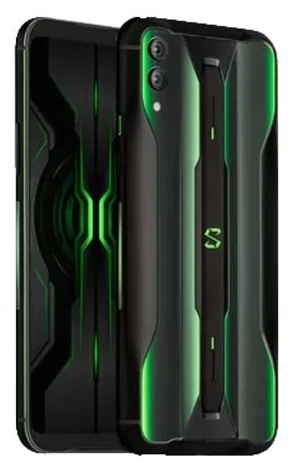
The selection will be opened by the traditionally most inexpensive model, which no longer “pulls” on the budget status, although it is relatively inexpensive compared to the top flagships. This point is especially important if you understand that Xiaomi Black Shark 2 Pro is the freshest edition of a smartphone for gamers of production Xiaomi, which was developed precisely with this initial positioning.
The CPU Qualcomm Snapdragon 855 in its overclocked Plus version is installed here. RAM can be installed 8 or 12GB, internal memory – up to 256GB, and it uses advanced and fast memory on UFS3.0 chips. To cool the chipset, a proprietary development Xiaomi is used – a compact liquid cooling system with direct contact using Direct touch liquid cooling system 3.0 technology.
Smartphone dimensions – 75.01×163.61×8.77mm, weight – 205g. The main body color is black with design elements and game-style lighting – they can be of other shades. Diagonal AMOLED – screen – 6.39 inches, matrix resolution – 2340×1080 with a density of 403 pixels per inch. The proportions are 19.5: 9.
On the back is a block of two cameras 48 and 12Mpix with apertures F / 1.75 and F / 2.20, respectively. Autofocus, macro mode, video shooting in 4K 3840×2160, flash. Front selfie camera resolution – 20MP.
In terms of communications, this model supports the entire range of cellular network standards up to LTE and LTE-A, wireless connection to Wi-Fi 802.11ac networks, direct wireless connection of devices Bluetooth 5.0 and Wi-Fi Direct. Satellite navigation – BeiDou, GLONASS, GPS (with A-GPS support).
Power is provided by a battery of the same capacity as the previous model – 4000mAh. Charging via USB Type-C, Qualcomm Quick Charge 4+ supported.
As a gamer model, the Xiaomi Black Shark 2 Pro got a decent audio system. A pair of stereo speakers and a stereo microphone are installed here. There is also an intelligent noise cancellation system.
Additional functions: integrated in the screen fingerprint scanner, gyroscope, electronic compass, accelerometer, proximity sensor, light sensor, voice call, voice control.
Advantages
- AMOLED – screen;
- image quality;
- increased responsiveness and accuracy of the touch screen;
- productivity and speed of work;
- innovations and improvements against the background of the previous generation Xiaomi Black Shark;
- high-quality sound;
- fast charging;
- pronounced gamer, spectacular appearance.
disadvantages
- no dust and moisture protection.
Huawei P30 Pro
Rating: 4.8
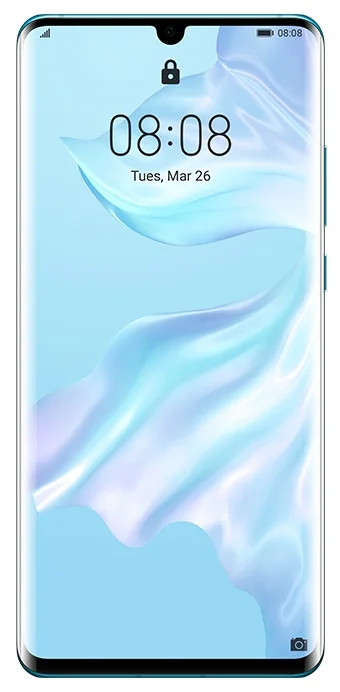
Now, consider the 2019 flagship from Huawei. Almost immediately after the official presentation, the model began to be called the 'best camera phone of the year', and this is not such an exaggeration. But the main advantage of the gadget is its own powerful HiSilicon Kirin 980 processor Huawei.
HiSilicon Kirin 980 is an 8-core processor based on the most advanced 7nm process technology at the time of development. 2 cores ARM Cortex-A76 with a frequency of 2.6 GHz, two of the same with a frequency of 1.92 GHz and four Cortex-A55 with a frequency of 1.58 GHz. Graphics – Mali-G76 MP10. RAM – 8GB, there can be two built-in options – 256 or 512GB.
Smartphone dimensions – 73.4x158x8.41mm, weight – 192g. Body materials – glass and aluminum. There is protection against dust, splashing water and even complete immersion in water for a short time – IP68. Screen size 6.47. Matrix OLED with a resolution of 2340×1080 with a density of 398 pixels per inch. The aspect ratio of the screen is 19.5: 9. In this model, the developers have solved the problem of a huge 'monobrow' that the P20 Pro had – in the new generation of the series there is only a small teardrop notch in the camera area.
Typically for a flagship, this model received the best camera configuration that the manufacturer was capable of at that time. So, the rear block here consists of cameras with 40, 20 and 8Mpix sensors with a depth sensor. Remarkably, the main sensor was developed in-house by Sony specifically for Huawei. It has major improvements that take the quality of shooting to the next level, and this fact received instant and most positive feedback from buyers Huawei P30 Pro. Front camera – 32MP.
The set of wireless interfaces for communication and positioning is also flagship here: a dual-band Wi-Fi 802.11ac module, direct connection between devices via Bluetooth 5.0 and Wi-Fi Direct, infrared interface, NFC, satellite positioning via BeiDou, GLONASS systems and GPS with A-GPS support.
The smartphone is equipped with a 4200mAh high-capacity battery with the ability to wirelessly charge and fast charge Huawei SuperCharge. According to independent tests, the model can work in 720p video quality over Wi-Fi at an average screen brightness for up to 17 hours. In game mode – up to 8 hours, depending on the 'gluttony' of a particular game application.
Advantages
- OLED – screen;
- image quality;
- advanced cameras;
- extended set of wireless interfaces;
- photo quality;
- high performance;
- protection IP68;
- autonomy.
disadvantages
- mono speaker.
ASUS ZenFone 6
Rating: 4.7
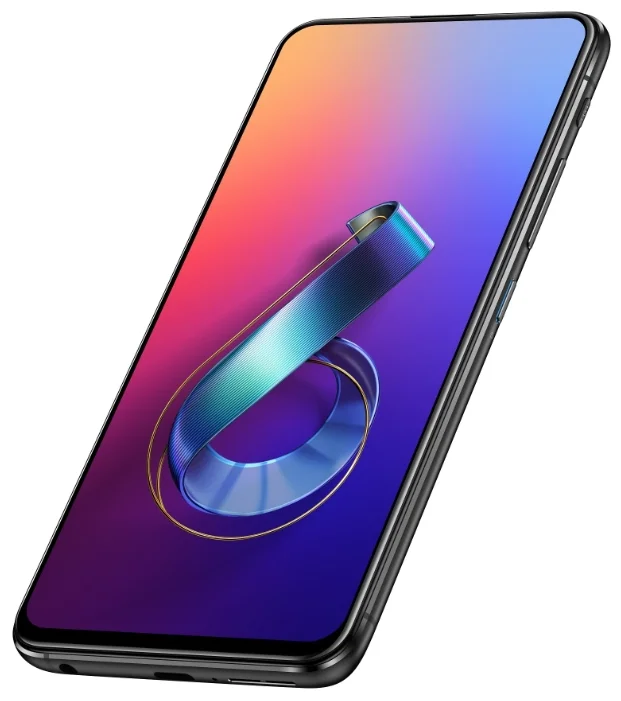
The review is continued by a representative of the famous ZenFone family from ASUS, namely the flagship of the sixth generation ASUS ZenFone 6. The processor here is expected to be the most powerful at that time Qualcomm Snapdragon 855.
It's not even worth starting your acquaintance with this model with a processor, since this review of the 855 Snapdragon will surprise no one. But special attention should be paid to how ASUS engineers solved the problem of combining a front camera with the general desire of developers for a frameless form factor. In this model, the creators decided to abandon the front camera … But, by no means to the detriment of selfies, otherwise it would have been a verdict of ASUS ZenFone 6 even before the official release. The engineers resorted to a combined solution – the main camera is located on a retractable swivel mechanism, and, depending on the mode, works as a rear or front camera.
Smartphone dimensions – 75.44×159.1×9.1mm, weight – 190g. Materials – metal and glass. The screen measures 6.4 inches diagonally. The matrix here is surprisingly not OLED, but IPS, which is strange for a flagship. IPS may look like an advantage when compared to smartphones based on VA matrices, but it certainly loses OLED in all respects. The resolution is 2340×1080 with a pixel density of 403 ppi. The proportions are 19.5: 9.
Now let's clarify about the cameras themselves, regardless of the mechanism. This model has a pair of cameras on the back – 48 and 13 megapixels. The same retractable swivel panel houses the LED flash. So at the same time the problem of flash for selfies is solved. The smartphone can shoot video in 4K quality at up to 60fps. Surprisingly, in this model, the developers decided not to abandon the classic 3.5mm audio jack. Many consider this an advantage.
ASUS ZenFone 6 has the same wide range of wireless interfaces as the one described above Huawei – Wi-Fi 802.11ac, Bluetooth 5.0, Wi-Fi Direct support, NFC module; satellite positioning by BeiDou, GLONASS and GPS.
Another very noteworthy quality of ASUS ZenFone 6 is the battery. Its capacity is 5000mAh, it supports Qualcomm Quick Charge 4 fast charging via USB Type-C. A full charge lasts up to 33 hours of talk time or over 600 hours of standby.
Advantages
- flagship functionality;
- performance and speed;
- classic 3.5mm audio jack;
- interesting engineering solution with a hybrid front-rear camera;
- capacious battery.
disadvantages
- IPS matrix (OLED would be more appropriate).
Samsung Galaxy S10 +
Rating: 4.6

When compiling a selection for the review, the 'Korean answer' to Cupertin's iPhone Xs Max could not but get into the field of view of specialists. This is a whole series of Galaxy S10 from three modifications – the younger S10e with a flat screen, the 'medium' S10 and the maximum S10 + with a larger screen size and a number of improvements. The processor in all three modifications is the same – the proprietary Samsung eight-core Exynos 9820. Graphics – Mali-G76 MP12.
We will take a look at the series using the example of the most interesting top model Galaxy S10 +. Here, in addition to powerful electronics and, as a result, high performance, there are also elements of personality that border on luxury. So, in S10 + glass and ceramics prevail in the case materials. This adds to it an impressive share of the cost, but many people are ready to pay even more for such an elite flagship, although there are plenty of complaints about the high price too. Smartphone dimensions – 74.1×157.6×7.8mm, weight – 175g.
The screen size here is 6.4 inches diagonally with a matrix AMOLED. The proportions are 19: 9. Curved screen. The matrix resolution is the highest in comparison with the previous models – 3040 × 1440. Rear Camera Configuration: 12MP Wide Angle, 16MP Ultra Wide Angle, 12MP Telephoto Lens. 8MP front camera with variable depth of field.
Wireless interfaces are presented here with the latest progress: Wi-Fi of the extended 802.11ax standard, Bluetooth 5.0, Wi-Fi Direct, NFC module, ANT + (secure wireless data transmission for sports equipment); satellite positioning BeiDou, GLONASS, GPS.
The battery here does not shine with an increased capacity – 4100mAh, but this is not the worst option with the proper level of optimization, and this model is doing well with this. A full charge lasts 100 hours of standby or up to 25 hours of talk time.
Truly impressive results have been achieved by the developers in terms of sound. Some time ago, Samsung Corporation acquired Harman Kardon (the holder of the AKG brand and some other well-known brands). But the full-fledged work of Harman Kardon specialists on the new sound in Samsung smartphones was embodied only in the 10th generation. The sound in the Galaxy S10 series was created virtually from the ground up and the result surpassed all expectations.
Advantages
- premium class;
- ceramics in the case;
- matrix AMOLED;
- record resolution;
- image quality;
- productivity and speed of work;
- exceptionally high quality sound.
disadvantages
- slow ultrasound finger scanner.
ASUS ROG Phone 2
Rating: 4.5

Now we turn to the analysis of the model, which simply could not be missing in our review. It is a full member of the Republic of Gamers family – ASUS ROG Phone 2 gaming smartphone. This is the second version of ASUS ROG Phone, which fixes the first mistakes and adds some other important improvements. The processor is quite expected here – the flagship Qualcomm Snapdragon 855 Plus with the Adreno 640 'native' graphics.
Before a detailed analysis, let's say that this is the best gaming smartphone for its time. The aforementioned Black Shark 2 Pro makes it a rather uncertain competition, and they missed the Razer Phone 2 in time, and that was not without flaws.
Externally, ASUS ROG Phone 2 is not much different from its predecessor. The same relatively massive case with characteristic decorative artifacts in the backlit design, hinting at the 'class belonging' of the device. Dimensions – 77.6×170.99×9.48mm, weight – 240g. Here, in addition to outstanding electronics, there are also some improvements to the application plan – for example, an additional input for connecting power, AirTriggers controls, and many additional accessories in the delivery set. In fact, from a complete set of components based on 'just' a smartphone, you can assemble an almost complete game console.
The screen size of ASUS ROG Phone 2 is 6.59 diagonally, the resolution of a high-quality AMOLED matrix is 2340×1080 with a pixel density of 391 per inch. The aspect ratio is 19.5: 9. At first glance, the configuration of the cameras is not bad – two rear cameras at 48 and 13 megapixels, plus a front camera at 24 megapixels. In fact, these cameras are noticeably inferior in the quality of the resulting photo and video material to other flagships, and not only to flagships.
As for autonomous work, here it is provided by the most capacious battery in our review – 6000mAh. There is a fast charging function Qualcomm Quick Charge 4.
Advantages
- premium class;
- game model;
- exceptional performance;
- high refresh rate of the screen;
- additional controls for the game mode;
- backlit design elements;
- capacious battery;
- the richest equipment.
disadvantages
- the quality of photo and video shooting is far from the best for this class of smartphone.
OnePlus 7T Pro
Rating: 4.4
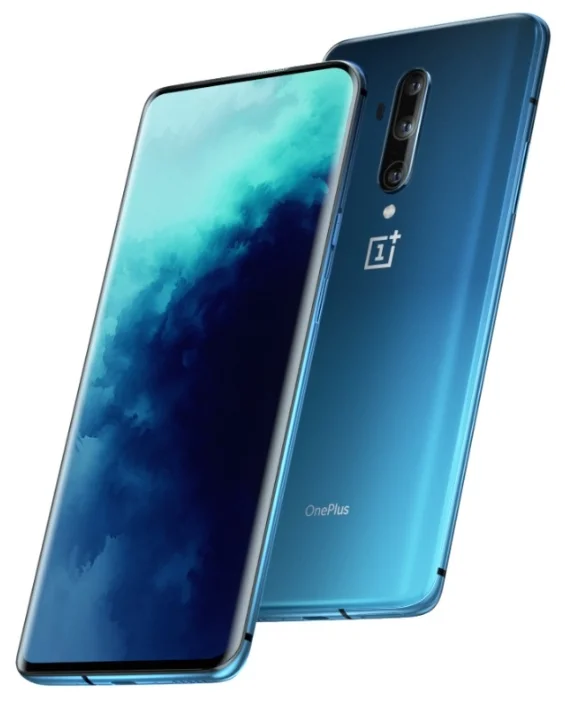
The penultimate in the list and the last in the review is a smartphone with a top-end overclocked processor Qualcomm Snapdragon 855 Plus. This is the OnePlus 7T Pro in all its high-tech glory and the rest of the premium electronics. This is also a flagship, as you might guess. A logical and successful continuation of the super successful previous version of OnePlus 7 Pro (without the T index in the name).
Device dimensions – 75.9×162.6×8.8mm, weight – 206g. Matte body, bezel-less screen with curved edges. The screen size is 6.67 inches. Matrix – AMOLED with a record resolution of 3120×1440 and even more record pixel density – 515 per inch. The aspect ratio is 19.5: 9. Screen refresh rate – 90Hz. This is not 120Hz, as in gaming models, but not 60Hz, as in budget models.
Rear camera kit – 48, 8 and 16MP. The developers decided to eliminate the 'monobrow' problem completely, and not be limited to half measures like a teardrop-shaped cutout around the camera lens. Therefore, the front camera of this model is 'periscope', that is, retractable. Front camera resolution – 16MP. The smartphone shoots video in 4K 3840×2160 resolution. Frame rate – up to 60fps depending on resolution.
From communications, there is a dual-band Wi-Fi 802.11a / b / g / n / ac module, a direct communication module with devices Bluetooth 5.0 with support for LE, A2DP and aptX HD codec, an NFC module. The USB 3.1 Type-C connector is used for wired connection of a smartphone to a computer, charging and connecting accessories such as a keyboard and mouse using OTG technology.
The smartphone's electronics are powered by a non-removable lithium-ion battery with a capacity of 4085mAh. There is a fast charging 30W.
Advantages
- flagship features;
- AMOLED – matrix;
- image quality;
- productivity and speed of work;
- retractable camera (no 'monobrow' and other cutouts on the screen surface);
- exceptionally solid appearance.
disadvantages
- there is no reader for memory cards.
iPhone XS Max
Rating: 4.3

According to the magazine, traditionally something special concludes the review of the best smartphones with a powerful processor. And here it is 'just' iPhone XS Max, about which even those who have never touched technology in their life know a lot Apple. In order not to repeat what has already been said a hundred times, we will focus only on the key points.
So, first the main thing is the processor. The most recent achievement of the Cupertinians is installed here – a proprietary processor Apple A12 Bionic based on a 6-core ARM microprocessor. The technical process is 7nm. Manufactured by a third party special order Apple.
Smartphone dimensions – 77.4×157.5×7.7mm, weight – 208g. Supports two sim cards of nano SIM + eSIM formats. A 6.5-inch screen diagonal with a matrix OLED with a resolution of 2688×1242 and a pixel density of 456 per inch. The aspect ratio is 19.5: 9.
There are only two rear cameras here – with a resolution of 12MP each and apertures of F / 1.80. The rear unit supports auto focus, 2x optical zoom, optical stabilization and macro mode. Front camera – 7MP. The rear unit can shoot video in 4K 3840×2160 resolution with frame rates up to 60fps.
There are all the means of communication typical for the flagship – Wi-Fi 802.11ac, Bluetooth 5.0, NFC, satellite navigation GLONASS and GPS. The built-in lithium-ion battery provides up to 25 hours of talk time. There is fast and wireless charging. User identification by Face ID.
Advantages
- brand;
- impeccable image quality;
- optimization typical for Apple;
- high performance;
- all the advantages of the operating system iOS;
- autonomy;
- fast and wireless charging.
disadvantages
- equipment has become poorer in comparison with previous models;
- typical claims of a subjective nature to the whole 'apple' technique.
Attention! This rating is subjective and does not constitute an advertisement and does not serve as a purchase guide. Before buying, you need to consult with a specialist.


